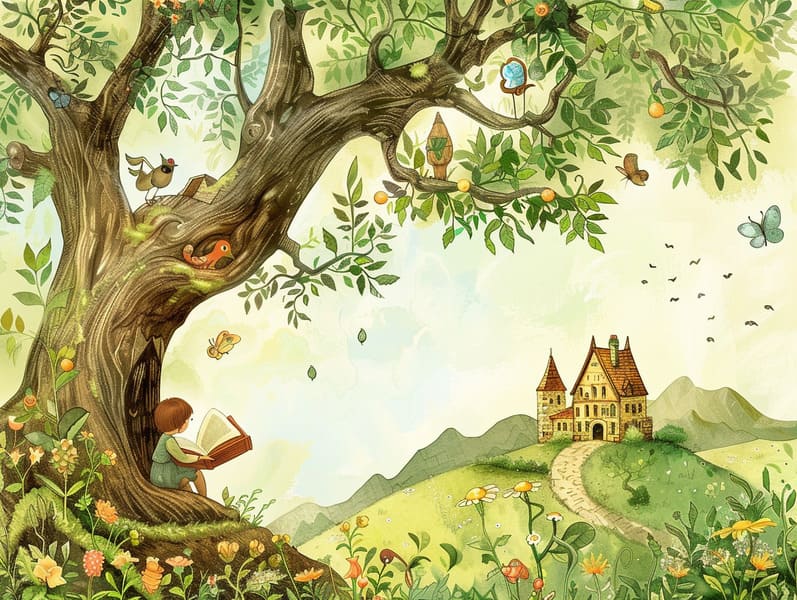The Emergence of Bedtime Fairy Tales with Their Continued Majesty.
The Emergence of Bedtime Fairy Tales with Their Continued Majesty.
Blog Article

Famous fairy tales have enduring presence. These tales have been whispered from one generation to the next far before they were ever recorded. They developed from a variety of backgrounds, including Asian traditions. They were initially told among grown-ups, often carrying themes and messages relevant to the societal norms and beliefs of the time.
The Grimm brothers, Jacob and Wilhelm, were among the first to compile and publish many of these beloved fairy tales. Their anthology, "Grimm's Folk Tales," included classics like "The Little Glass Slipper," "The Story of Hansel and Gretel," and "Little Snow White," which have since become staples in the world of beloved fairy tales. Similarly, Andersen's whimsical stories, such as "The Sea Maid," and "The Duckling that Could," have stolen hearts worldwide, establishing their place in the pantheon of timeless fairy tales.
Though they are centuries old, traditional fairy tales remain as pertinent as ever, especially as children's night stories. These charming stories are now available in numerous formats, including colorful picture books, captivating animations, and digital fairy tales.
Their continued relevance can be linked to several delightful features:
Significant Morals: Ancient fairy tales often teach important moral lessons. Stories like "The Wolf and the Liar" teach the merit of honesty, while "The Race of the Tortoise and the Hare" highlight the benefits of steadfastness and modesty. These narratives offer young readers clear distinctions between truth and falsehood, building their moral compass in a gentle yet significant way.
Compassion and Knowledge: Traditional fairy tales frequently depict heroes facing struggles and tests, fostering kids to sympathize with their struggles and champion their triumphs. For instance, "The Tale of Beauty and the Beast" highlights the value of seeing beyond looks to recognize the inner core of a character, building sympathy and knowledge.
Cultural Knowledge: Many fairy tales are interwoven with the cultural contexts from which they blossomed. Delving into these fairy tales can provide fascinating glimpses into different beliefs, cultivating a sense of world awareness and knowledge.
Imagination and Creativity: The supernatural elements in timeless fairy tales—enchanted forests—fire up children’s fantastical thinking. These fairy tales take readers to enchanted realms, enhancing innovative dreams and a sense of amazement that lasts a lifetime.
Timeless fairy tales are not only entrancing but also enlightening. They provide mesmerizing tools in fostering various intellectual and emotional capacities in kids. When classic fairy tales are spoken, they strengthen language acquisition by offering new language and complicated sentence structures. This practice also boosts listening abilities and mindfulness, as kids concentrate deeply, eager to see what happens next.
Furthermore, exploring the themes and characters of ancient fairy tales can advance thinking skills and intellectual skills. The young are shown to recognize patterns, predict happenings, and know cause and effect. These deliberations also advance little ones reveal their thoughts and feelings, fostering their emotional intelligence.
In today’s information age, the abundance of digital storybooks has made these fairy tales more obtainable than ever. Online resources and applications feature broad selections of Grimm's fairy tales that can be seen or listened via anytime, anywhere. Fairy tales voiced are particularly popular, giving an immersive method for kids to take part in these entrancing tales. Voice books and read-to-me videos move characters and settings to life, often supplemented by enchanting melodies and melodies that heighten the narrative journey.
The timeless allure of old fairy tales lies in their ability to shift to modern society while keeping their key morals. Contemporary updates of these narratives often introduce more varied protagonists and modern settings, making them relatable to today’s audience. However, the main ideas of boldness, kindness, and justice remain unchanged, continuing to connect with kids of all ages.
Old fairy tales also offer a sense of solace and homeliness. They allow a orderly narrative with a clear beginning, middle, and end, often wrapping up with the culmination of conflicts and the triumph of righteousness over wickedness. This constancy can be comforting for young ones, gifting a sense of dependability in an unstable world.
Timeless fairy tales continue to delight and train new generations, maintaining their grandeur and pertinence in modern society. As children's night stories, they distribute a perfect blend of captivation and insight, promoting moral values, empathy, and creativity. The existence of digital storybooks and the popularity of fairy tales read out loud warrant that these traditional stories remain accessible to new generations.
By upholding and passing on these tales, we continue to revere the rich tapestry of lore and cultural heritage. Whether you are exploring a artistically illustrated book, viewing a cyber library, or listening through an audiobook, the allure of popular fairy tales is always within reach. These stories teach us of more info the persistent force of tales and its ability to connect us across eras and regions.
No matter if you are viewing a richly illustrated book, viewing a web-based library, or hearing an spoken story, the allure of old fairy tales is always within reach.
These tales teach us of the steadfast presence of fairy tales and its ability to link us across generations and cultures, weaving a spell that delights and instructs alike.